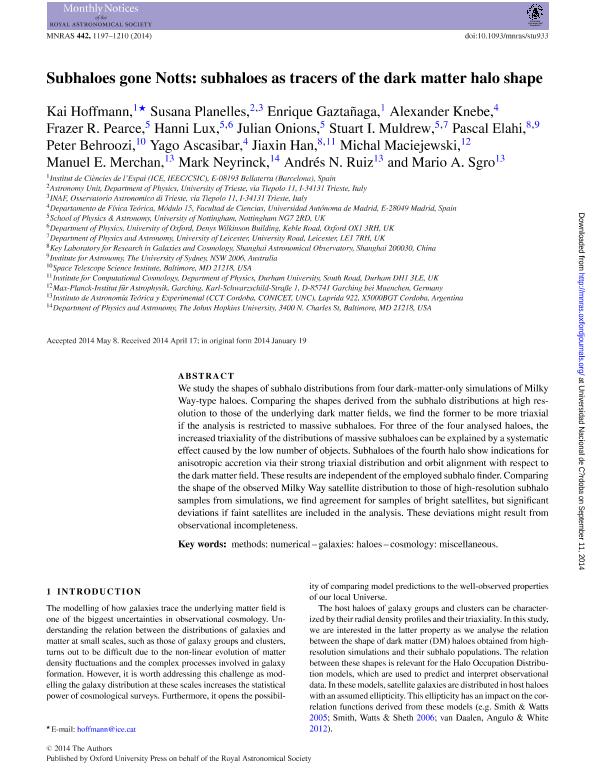Mostrar el registro sencillo del ítem
dc.contributor.author
Hoffmann, Kai
dc.contributor.author
Planelles, Susana
dc.contributor.author
Gaztañaga, Enrique
dc.contributor.author
Knebe, Alexander
dc.contributor.author
Pearce, Frazer R.
dc.contributor.author
Lux, Hanni
dc.contributor.author
Onions, Julian
dc.contributor.author
Muldrew, Stuart I.
dc.contributor.author
Elahi, Pascal
dc.contributor.author
Behroozi, Peter
dc.contributor.author
Ascasibar, Yago
dc.contributor.author
Han, Jiaxin
dc.contributor.author
Maciejewski, Michal
dc.contributor.author
Merchan, Manuel Enrique

dc.contributor.author
Neyrinck, Mark
dc.contributor.author
Ruiz, Andrés Nicolás

dc.contributor.author
Sgró, Mario Agustín

dc.date.available
2018-01-17T13:01:18Z
dc.date.issued
2014-08
dc.identifier.citation
Neyrinck, Mark; Behroozi, Peter; Lux, Hanni; Onions, Julian; Elahi, Pascal; Gaztañaga, Enrique; et al.; Subhaloes gone Notts: subhaloes as tracers of the dark matter halo shape; Wiley Blackwell Publishing, Inc; Monthly Notices of the Royal Astronomical Society; 442; 2; 8-2014; 1197-1210
dc.identifier.issn
0035-8711
dc.identifier.uri
http://hdl.handle.net/11336/33574
dc.description.abstract
We study the shapes of subhalo distributions from four dark-matter-only simulations of Milky Way-type haloes. Comparing the shapes derived from the subhalo distributions at high resolution to those of the underlying dark matter fields, we find the former to be more triaxial if the analysis is restricted to massive subhaloes. For three of the four analysed haloes, the increased triaxiality of the distributions of massive subhaloes can be explained by a systematic effect caused by the low number of objects. Subhaloes of the fourth halo show indications for anisotropic accretion via their strong triaxial distribution and orbit alignment with respect to the dark matter field. These results are independent of the employed subhalo finder. Comparing the shape of the observed Milky Way satellite distribution to those of high-resolution subhalo samples from simulations, we find agreement for samples of bright satellites, but significant deviations if faint satellites are included in the analysis. These deviations might result from observational incompleteness.
dc.format
application/pdf
dc.language.iso
eng
dc.publisher
Wiley Blackwell Publishing, Inc

dc.rights
info:eu-repo/semantics/openAccess
dc.rights.uri
https://creativecommons.org/licenses/by-nc-sa/2.5/ar/
dc.subject
Methods: Numerical
dc.subject
Galaxies: Haloes
dc.subject
Cosmology: Miscellaneous
dc.subject.classification
Astronomía

dc.subject.classification
Ciencias Físicas

dc.subject.classification
CIENCIAS NATURALES Y EXACTAS

dc.title
Subhaloes gone Notts: subhaloes as tracers of the dark matter halo shape
dc.type
info:eu-repo/semantics/article
dc.type
info:ar-repo/semantics/artículo
dc.type
info:eu-repo/semantics/publishedVersion
dc.date.updated
2018-01-03T20:10:42Z
dc.journal.volume
442
dc.journal.number
2
dc.journal.pagination
1197-1210
dc.journal.pais
Reino Unido

dc.journal.ciudad
Londres
dc.description.fil
Fil: Hoffmann, Kai. Instituto de Ciencias del Espacio. Barcelona; España
dc.description.fil
Fil: Planelles, Susana. Università degli Studi di Trieste; Italia
dc.description.fil
Fil: Gaztañaga, Enrique. Instituto de Ciencias del Espacio. Barcelona; España
dc.description.fil
Fil: Knebe, Alexander. Universidad Autónoma de Madrid; España
dc.description.fil
Fil: Pearce, Frazer R.. The University Of Nottingham; Reino Unido
dc.description.fil
Fil: Lux, Hanni. The University Of Nottingham; Reino Unido. University of Oxford; Reino Unido
dc.description.fil
Fil: Onions, Julian. The University Of Nottingham; Reino Unido
dc.description.fil
Fil: Muldrew, Stuart I.. The University Of Nottingham; Reino Unido. University of Leicester; Reino Unido
dc.description.fil
Fil: Elahi, Pascal. Shanghai Astronomical Observatory; China. The University of Sydney; Australia
dc.description.fil
Fil: Behroozi, Peter. Space Telescope Science Institute; Estados Unidos
dc.description.fil
Fil: Ascasibar, Yago. Universidad Autónoma de Madrid; España
dc.description.fil
Fil: Han, Jiaxin. Shanghai Astronomical Observatory; China. University Of Durham; Reino Unido
dc.description.fil
Fil: Maciejewski, Michal. Max-Planck-Institut f ̈ur Astrophysik; Alemania
dc.description.fil
Fil: Merchan, Manuel Enrique. Consejo Nacional de Investigaciones Científicas y Técnicas. Centro Científico Tecnológico Conicet - Córdoba. Instituto de Astronomía Teórica y Experimental. Universidad Nacional de Córdoba. Observatorio Astronómico de Córdoba. Instituto de Astronomía Teórica y Experimental; Argentina
dc.description.fil
Fil: Neyrinck, Mark. University Johns Hopkins; Estados Unidos
dc.description.fil
Fil: Ruiz, Andrés Nicolás. Consejo Nacional de Investigaciones Científicas y Técnicas. Centro Científico Tecnológico Conicet - Córdoba. Instituto de Astronomía Teórica y Experimental. Universidad Nacional de Córdoba. Observatorio Astronómico de Córdoba. Instituto de Astronomía Teórica y Experimental; Argentina
dc.description.fil
Fil: Sgró, Mario Agustín. Consejo Nacional de Investigaciones Científicas y Técnicas. Centro Científico Tecnológico Conicet - Córdoba. Instituto de Astronomía Teórica y Experimental. Universidad Nacional de Córdoba. Observatorio Astronómico de Córdoba. Instituto de Astronomía Teórica y Experimental; Argentina
dc.journal.title
Monthly Notices of the Royal Astronomical Society

dc.relation.alternativeid
info:eu-repo/semantics/altIdentifier/doi/http://dx.doi.org/10.1093/mnras/stu933
dc.relation.alternativeid
info:eu-repo/semantics/altIdentifier/url/https://academic.oup.com/mnras/article/442/2/1197/985032
Archivos asociados
